Is it too early to pine for the glory days of 2006? We were right on the cusp of free music-recording software making its way into every dorm room and basement across the globe, Soulseek was expanding the iPods of nearly every web-savvy twenty-something and stores still sold CDs, or at least tried to. Oh, and Times New Viking were initially making waves with their humble, back-to-roots form of indie-rock, back when the genre was an actual alternative to the mainstream and didn’t just signify an ever-growing slice of the mainstream. They kept putting out great records up through and including their last one, which may or may not be their last, and I was delighted to pick the brain of keyboardist/vocalist Beth Murphy, who clearly has thought a lot about everything, often with hilariously insightful and poignant results.
Are Times New Viking officially over? I don’t believe there was ever any official announcement. Perhaps Times New Viking isn’t a “formal press release announcement” sort of band?
You nailed it. That, and the notion of a band “breaking up” is a kind of received idea that no band stands by anyway.
Do you ever think about the dozens (hundreds?) of “lo-fi” bands that came about in the wake of Times New Viking, and thought, “God, what have we done?”?
We didn’t do that; Pitchfork and the rest circa 2008 did that. The only culture event we’re responsible for is resurrecting Siltbreeze Records by making a CD-R for our friends and family to listen to that made its way to Tom Lax in 2005.
I do agree with your making the term alleged by putting it in quotation marks. In fact, that should be the genre’s official written presentation: “lo-fi.â€
As far as what music genre terms are made of, there is nothing like ​it. It’s a genre named after a description of the audio sound, but that audio sound is also not exclusive to the genre. It’s similar to electronic music in this way. Meaning, there is electronic music, and then there’s one-man melodic black metal made by electronic means. There is lo-fi, and then there’s Crossed Out or Burzum who never had to answer these questions.
​But e​lectronic music is further legitimized ​by​ instruments ​specific​ to the genre. “Lo-fi†doesn’t have that. Further, “lo-fi†only refers to recorded audio sound. (Lugging a PA system on tour to run vocals through is a conceit to be ignored.)
So! The origin story of “lo-fi†is wholly in the recorded artifact, rather than the live and recorded composite. And this is where it gets interesting; because if you trace music back to when the recorded version emerged as the ideal over the live version, you’ll find yourself at the birth of rock-and-roll as we know it.
It’s almost impossible to read about Times New Viking without the “lo-fi” thing coming up (as proven by this interview too, I suppose). Do you feel as though other great things the band has done, like specific lyrics or hooks that you’ve written, or memorable live performances, just kind of get ignored in favor of the buzz word? Or are we hopefully past all that in 2015 (the downside being that everyone has moved on to other indie “trends” to think about)?
When our music gets boxed in that way, it’s at a level that has no business discussing it the first place. With enough publicity, everything gets typecast. How much it takes for this to happen varies, but it always felt unprecedentedly minimal for us. Our music was certainly covered on a scale in which it was never intended. This was a confluence of us getting signed to Matador at the same time music media was expanding online to the scope we know today. I first heard of “Best New Music†when Adam’s brother told me we got it. Folks needed content, and these luddites from Ohio — now endorsed by a respectable major indie — had just released a record with a fidelity fit to mirror the economic collapse. Shit writes itself.
The best writing about our band comes from Internet-generated English translations of reviews written in a foreign language. That illiterate poetic slippage captures us perfectly.
Conversely, the fact that Shazaam will recognize a song as Times New Viking, but get the song wrong every time, is a perfect analogy for the particular brand of shitty music writing we’ve inspired.
What do you miss more: the swank European festivals or the random Midwestern basements?
The fondest memories are in random basements. That’s where the evidence of what we did having any meaning is stored. Shit felt pure. In-the-momentness happened. One thing I miss about playing live is being 100% present in a moment. It doesn’t happen in real life.
That said, at this moment, I’d take a fat European-festival paycheck before I’d agree to all that woo-woo alone. Just me being practical and in my thirties. And basement shows are ​an inevitability​.

If all of Times New Viking’s material was permanently destroyed but for one song, which song would you want to survive?
On the Friday you sent this question, my first thought was “Teenage Lust.†To be sure, (or more accurately, because I had the house to myself, my band is my “guilty pleasure,†and it had been awhile) I pulled all the Times New Viking records from the shelf, made a small stack on the coffee table, and started listening at high volume. It was during “Teenage Lust†that I suddenly did not have the house to myself anymore. So I shut it down — this kind of behavior is obnoxious, even to a life partner I won the lottery with, and I already knew this song was the answer. What I didn’t know was that it would be the last song we heard in our house before it was broken into that weekend, the thief making off with: our receiver, television, record player, a fan, video camera, and all of the records that were still on the shelf. Because we were out of town when it happened, and only had the house-sitter as first responder to relay the scene, I didn’t realize until I got home that the Times New Viking stack I set on the coffee table, an act triggered by your question, had been spared.
Correct me if this is reductive, but your hypothetical could have been anything eliciting my favorite Times New Viking song; it may as well have been some variation of what played out.
Before I got home and realized the Times New Viking records were left, I reflected on the question as a spooky prologue to its own manifestation-somewhat. Then, and now, its some kind of precognitive firefighter.
(There is actually a third layer to this, that’s a little hairy to get into now. Let’s just say the Times New Viking record stack may have offered a clue…)
So yeah. Magical thinking reaches an all-time high whenever shit hits the fan.
After the success of Times New Viking, would you be willing and able to start a new band that does a CD-r to pass around to friends, play house parties for donations, sleep on a stranger’s floor, or are you spoiled by the success you’ve had? What I’m wondering is, is it possible to get a taste of fat European paychecks and hotel rooms with separate beds and then go back to starting from scratch?
Look, success is relative, but I’m afraid you’re overstating ours. Let’s just say Pomplamoose would have had a problem. And sleeping on the floor was always probable. Sure, from 2008 to 2011, we eked out a living touring six to eight months out of the year and bartending / working record store jobs back in “cheap beer, cheap rent, Indian mounds†Columbus, Ohio the remaining four to eight.
Unless you mean successful for a band like us; that, I’d understand. But then, that’s not really success, is it? “Success†implies hotel rooms and tickets to Europe were ever goals. Certainly not. As my friend Bobcat Goldthwait says, success is for creeps. We were blessed or lucky hard workers who just ran with it. We were shepherded toward each of our opportunities by people whose opinion we counted.
But to answer your question: It’s naive and transparent to take money as granted in the pursuit of music. Nobody is going to pay you to be yourself. Even in low Heatseeker degrees of popularity, it’s going to be uncomfortable. For professional artists to business professionals alike, to make it, you’ve got to be willing to play the game. A person decides what game they have the capacity for: what they are willing to mitigate, risk, etc.
For us, the trappings of eking out a living in that way began to discourage creativity, something we didn’t want to risk. It wasn’t that it was all that gross. If you’re philosophically intuitive these signature sell-out moments have their appeal. (A Kia Soul show in Cincinnati played to about 25 folks who were all optioned free packs of Camel Lights stands out.) It was the ennui of it: Twenty too many attempts to capture our image (why aren’t you guys more photogenic?); lip service, broken record, college credit press, canned response (only twice were we interviewed by someone older than us, one was John Norris); seeing bands like No Age and Wavves soar past us, seeing bands like No Age and Wavves on tour, only seeing bands like No Age and Wavves on tour.
Turns out I’d rather play someone else’s game than have someone play mine.
Get a job. Make art. Maybe in the next economy it will be different. I kinda buy into the whole “future of no work” thing.
How integral was Columbus, both its musical scene and general style of living, to Times New Viking? It always seemed like Columbus was mentioned in conjunction with Times New Viking, almost as if you were its musical representatives.
Columbus was super integral. Because it has no national identity, the artists and musicians living there feel no weight of influence, allowing for ad hoc gangs of meaning.
But we are hardly its musical representatives. That belongs to a clutch of ‘80s – ‘90s bands: V-3, Scrawl, Thomas Jefferson Slave Apartments, Gaunt, Mike Rep and the Quotas, New Bomb Turks, Gibson Brothers, the list goes on.
Many members of these bands, or even the bands themselves, were still active in Columbus music when we started playing. If not active, any dormancy was slight enough to be disrupted when a small scene emerged post-Y2K. Not old enough to be our parents, but with established legacies to behold, the sounds and stylings of this music was in our DNA. It was not for nostalgia’s sake that we recorded on four tracks and liked loud and fuzzy rock music, it was the only we would ever be.
Keep in mind, we all graduated high school in 2000; it was 2003 when the band formed. Our adult sensibilities were established before the internet began its sociocultural effect.
We were on the last bus of organic influence.
Who did your cover art? The sort of collage-y, hand-written notes with scribbling and whatnot seems inseparable from your music – like I don’t think I’d process it the same way if your records came out looking like Klaus Schulze’s or something.
As part of our 300% creative control business model, we all did. We met in art school, so it could be said that our visual aesthetic was agreed on before anything else.
What were the best aspects of working with Matador and Merge? Were they vastly different labels to work with, in how they operated, or was it kinda the same thing?
Aside from the fact that we were with Matador for two albums and an EP, and with Merge for one album, operations were pretty much the same. We could email Mac or Gerard respectively, tell the same jokes around them.
Do you feel bad for bands starting today, that they can’t exist in any sort of anonymity thanks to the overwhelming presence of the internet? Would you want to start a new band soon, or does it seem exhausting?
Any degree of online anonymity can be managed if desired (False, His Hero is Gone, Tragedy). Some bands only use Bandcamp, a lot of obscure stuff can be found on Soundcloud. The internet doesn’t look good on bands that go all-in with it from the get-go, but a band with a marketing strategy is nothing new.
The internet is neither good nor bad, it’s the ebb and flow of applications that affect certain culture industries, and in real time. Twitter has been great for comedians; podcasts are a new option for journalists. From 2003–2006, we worked MySpace. A group without much technological interest or knowledge could create what was essentially a networked website. You had complete control of the content: songs, tour dates, photos (and ours were only ever album art and flyers), videos, you could even change the page colors and backgrounds by editing the HTML (Fun fact: the open code feature was an oversight which became one of the platform’s main attractions). If you found a band that you liked, check out their “Top Friendsâ€! This was the networked part.
Anyway, I hope the fact that I’m waxing nostalgic about MySpace speaks to the absurdity of valuing the state of anything by the technologies that exist. I’m not saying, “back in the day, everything was different, because MySpace.†Technology is fleeting, good music is forever, and the internet isn’t going away either. \
I’d start a new band.
Would you feel comfortable going on record at confirming or denying the possibility of a Times New Viking reunion, say in 2020 or so?
I feel comfortable denying it. That way, if it ever happened it’ll be all the more unexpected and special.
We might record soon. I aspire to be one of those non-touring bands that just make records.
Acid Mothers Temple And The Melting Paradiso UFO High On New Heaven Live In New Haven 3xLP (Safety Meeting)
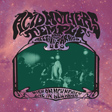 Perhaps it was Acid Mothers Temple’s quest for the most righteous pizza on Earth that led them to the quaint town of New Haven, CT, but whatever the basis for their arrival, they conjured their sonic séance expertly on April 20th, 2013, captured via a surprisingly clear recording and pressed onto six sides of 12″ vinyl. Chances are you know what Acid Mothers Temple is all about by now: half a dozen Japanese people on stage, one of them in a Degeneration X football jersey, rocking endlessly toward the astral plane… they’ve been doing it for decades now. This set is a pretty great sonic representation of what they’re all about, sans smoke machines and stage lights – there are plenty of extended guitar solos that tie Wah pedals to Echoplexes and fly them like kites, somber and trippy death marches that re-interpret the Kama Sutra, and a nearly thirty minute rendition of their perennial hit “Pink Lady Lemonade”. You could’ve watched an entire episode of Seinfeld in the time it took these cosmic jokers to build it up and coast it on down. Acid Mothers Temple are great, and such an institution at this point that I can only hope they outlive me… maybe it’s time I started thinking about what kind of a world I want to leave behind for Acid Mothers Temple.
Perhaps it was Acid Mothers Temple’s quest for the most righteous pizza on Earth that led them to the quaint town of New Haven, CT, but whatever the basis for their arrival, they conjured their sonic séance expertly on April 20th, 2013, captured via a surprisingly clear recording and pressed onto six sides of 12″ vinyl. Chances are you know what Acid Mothers Temple is all about by now: half a dozen Japanese people on stage, one of them in a Degeneration X football jersey, rocking endlessly toward the astral plane… they’ve been doing it for decades now. This set is a pretty great sonic representation of what they’re all about, sans smoke machines and stage lights – there are plenty of extended guitar solos that tie Wah pedals to Echoplexes and fly them like kites, somber and trippy death marches that re-interpret the Kama Sutra, and a nearly thirty minute rendition of their perennial hit “Pink Lady Lemonade”. You could’ve watched an entire episode of Seinfeld in the time it took these cosmic jokers to build it up and coast it on down. Acid Mothers Temple are great, and such an institution at this point that I can only hope they outlive me… maybe it’s time I started thinking about what kind of a world I want to leave behind for Acid Mothers Temple.
Badlands Dark Dreams 7″ (Porchcore)
 Dark Dreams sounds like a Ben & Jerry’s flavor I’d be interested in sampling, and it’s also the name of the two songs on this quaint and homely 7″ single, although the track “Dreams” is the a-side and “Dark” follows on the flip. “Dreams” will have your head swaying in no time, a friendly little cut of acoustic guitar-led indie-pop, with just enough suede fringe on the jacket to give off a lonesome country vibe. I’m reminded of the lighter side of K Records, maybe a touch of Lavender Diamond too (although a bit dimmer than Lavender Diamond’s sun-blasted jubilance). “Dark” works similarly, and although I can’t understand anything that band-leader Adrian Chi Tenney is singing, I can’t help but assume this song is about hopping trains to meet your lover on a cliff, only to find out that they threw themselves off it into the ocean because being apart was simply too much for them to bear. (Okay, the lyrics are printed inside the sleeve, but my interpretation still stands.) Two pretty songs that have that same sort of top-down, Kurt Vile’s hair-blowing-in-the-wind sorta feel, even as dusk starts showing up earlier in the evening.
Dark Dreams sounds like a Ben & Jerry’s flavor I’d be interested in sampling, and it’s also the name of the two songs on this quaint and homely 7″ single, although the track “Dreams” is the a-side and “Dark” follows on the flip. “Dreams” will have your head swaying in no time, a friendly little cut of acoustic guitar-led indie-pop, with just enough suede fringe on the jacket to give off a lonesome country vibe. I’m reminded of the lighter side of K Records, maybe a touch of Lavender Diamond too (although a bit dimmer than Lavender Diamond’s sun-blasted jubilance). “Dark” works similarly, and although I can’t understand anything that band-leader Adrian Chi Tenney is singing, I can’t help but assume this song is about hopping trains to meet your lover on a cliff, only to find out that they threw themselves off it into the ocean because being apart was simply too much for them to bear. (Okay, the lyrics are printed inside the sleeve, but my interpretation still stands.) Two pretty songs that have that same sort of top-down, Kurt Vile’s hair-blowing-in-the-wind sorta feel, even as dusk starts showing up earlier in the evening.
J.G. Biberkopf Ecologies LP (Knives)
 J.G. Biberkopf (German for “Justin Bieber fan”) is a newcomer to the post-post-modern avant-techno landscape, but as far as I’m concerned, his presence is welcomed. Not sure how he was discovered (plucked out of the Soundcloud minor leagues by some hard-working techno talent scout?), but Ecologies is a nice snapshot of what the undanceable underground is up to. Through these six tracks, Biberkopf offers rave motifs (huge swabs of electro-synths), technological sound-effects (the sound of a security camera rotating to follow you down a hallway), Graham Lambkin-esque found-sound (a dramatic cut to windshield wipers struggling across a dry windshield), the soundtrack to any given Stephen Seagal film, and Egyptrixx’s knack for making the listener feel like they just activated the power on a fleet of Terminators by mistake. And through it all, there’s some of Ben Frost’s macho-ambient atmosphere for good measure, too. It’s an immersive experience, and briskly paced so that I never lose interest – if anything, I find myself wanting to press rewind on specific musical moments that quickly pass through. I’m uncertain that Ecologies will hold up a couple years from now, as it seems to be an experiment in the specific musical technology currently offered to home-based producers, but the entire concept of the future is uncertain anyway, isn’t it?
J.G. Biberkopf (German for “Justin Bieber fan”) is a newcomer to the post-post-modern avant-techno landscape, but as far as I’m concerned, his presence is welcomed. Not sure how he was discovered (plucked out of the Soundcloud minor leagues by some hard-working techno talent scout?), but Ecologies is a nice snapshot of what the undanceable underground is up to. Through these six tracks, Biberkopf offers rave motifs (huge swabs of electro-synths), technological sound-effects (the sound of a security camera rotating to follow you down a hallway), Graham Lambkin-esque found-sound (a dramatic cut to windshield wipers struggling across a dry windshield), the soundtrack to any given Stephen Seagal film, and Egyptrixx’s knack for making the listener feel like they just activated the power on a fleet of Terminators by mistake. And through it all, there’s some of Ben Frost’s macho-ambient atmosphere for good measure, too. It’s an immersive experience, and briskly paced so that I never lose interest – if anything, I find myself wanting to press rewind on specific musical moments that quickly pass through. I’m uncertain that Ecologies will hold up a couple years from now, as it seems to be an experiment in the specific musical technology currently offered to home-based producers, but the entire concept of the future is uncertain anyway, isn’t it?
Blawan Hanging Out The Birds 12″ (Ternesc)
 Just as expected, Blawan’s second 12″ of 2015 on the Ternesc label is here, and it’s a mighty EP of downhill techno. I love Blawan, and I don’t expect that to ever change, but both of his newest 12″ EPs sound great in the most expected of ways, to the point where I’m slightly disappointed. He’s managed to create such distinct sonic territory for himself that it only takes a sludgy kick or frantic electronic wobble for me to recognize a Blawan track on sound alone, but on this EP in particular, it almost comes across like someone doing a really fantastic impression of Blawan, using all of his signifiers and trademarked synth settings without adding anything new or strange to the mix. The electronic chirp and incessant warble of “Mine Oh Mine” is particularly sweet, but these tracks just add to his total minutes of recorded material rather than elevate it further. Hanging Out The Birds is an urgent and carefully-crafted example of Blawan’s signature style, but my mind remains intact rather than splattered all over the ceiling.
Just as expected, Blawan’s second 12″ of 2015 on the Ternesc label is here, and it’s a mighty EP of downhill techno. I love Blawan, and I don’t expect that to ever change, but both of his newest 12″ EPs sound great in the most expected of ways, to the point where I’m slightly disappointed. He’s managed to create such distinct sonic territory for himself that it only takes a sludgy kick or frantic electronic wobble for me to recognize a Blawan track on sound alone, but on this EP in particular, it almost comes across like someone doing a really fantastic impression of Blawan, using all of his signifiers and trademarked synth settings without adding anything new or strange to the mix. The electronic chirp and incessant warble of “Mine Oh Mine” is particularly sweet, but these tracks just add to his total minutes of recorded material rather than elevate it further. Hanging Out The Birds is an urgent and carefully-crafted example of Blawan’s signature style, but my mind remains intact rather than splattered all over the ceiling.
Domenique Dumont Comme Ça LP (Antinote)
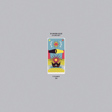 French electronic music is nothing if not distinctive, from Daft Punk to Justice to Air, and the Antinote label is a notable new wrinkle on its landscape. They’re almost like the passive European answer to the American-born L.I.E.S. label, merging deep-house and home-recorded aesthetics but focusing on retro / obscure electronic music and the lighter side of things. If Antinote is recording in a basement, it still has giant windows and plenty of natural light, if you catch my drift. This debut six-song “album” by Domenique Dumont, for example, is a delightful drizzle of coconut oil on my musical diet, recalling the beachy exotica of Pizzicato Five, Fantastic Plastic Machine or Stereolab, as if you’re laying out on a glistening European beach that shines like 8-bit Nintendo pixels and smells like Serge Gainsbourg’s aftershave. Dumont skips the funk-break samples, turntable scratching and other dated signposts for a more streamlined approach that at least nods in the direction of such contemporary cool as Peaking Lights and John Talabot, pursuing easy-going deep-house and breezy dub-exotica in equal measure. Ah, c’est si bon!
French electronic music is nothing if not distinctive, from Daft Punk to Justice to Air, and the Antinote label is a notable new wrinkle on its landscape. They’re almost like the passive European answer to the American-born L.I.E.S. label, merging deep-house and home-recorded aesthetics but focusing on retro / obscure electronic music and the lighter side of things. If Antinote is recording in a basement, it still has giant windows and plenty of natural light, if you catch my drift. This debut six-song “album” by Domenique Dumont, for example, is a delightful drizzle of coconut oil on my musical diet, recalling the beachy exotica of Pizzicato Five, Fantastic Plastic Machine or Stereolab, as if you’re laying out on a glistening European beach that shines like 8-bit Nintendo pixels and smells like Serge Gainsbourg’s aftershave. Dumont skips the funk-break samples, turntable scratching and other dated signposts for a more streamlined approach that at least nods in the direction of such contemporary cool as Peaking Lights and John Talabot, pursuing easy-going deep-house and breezy dub-exotica in equal measure. Ah, c’est si bon!
Ecstatic Vision Sonic Praise LP (Relapse)
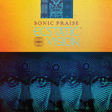 A lot of bands praise the riff, but Ecstatic Vision seems to take it a step further and praise the chord itself. One guitar ringing out the same holy chord while a bass repeats it on 8th notes can achieve transcendence as purely as any set of chord changes, if they have anything to say about it. Ecstatic Vision seem to dig on that pretty hard, allowing repetition and skin-tight playing to elevate minds, not unlike Boris or Acid Mothers Temple. They seem to mostly sing about what they’re doing, from desires to reach astral planes, sonic praise (“Sonic Praise”) and a general appreciation of all things righteously stoner. Doug Sabolick’s vocals are hoarse and Matt Pike-like, helping keep the Hawkwind-brand space shuttle grounded, at least until any given song breaks in the middle and they blast off, drums and bass locked into a perfect algorithm while the guitars aim for galaxies Hubble has yet to locate. It’s a tried and tested formula for sure, but I dunno, I don’t mind getting higher with a group as refined and talented as Ecstatic Vision, as it helps balance all the other times I find myself involuntarily getting lower.
A lot of bands praise the riff, but Ecstatic Vision seems to take it a step further and praise the chord itself. One guitar ringing out the same holy chord while a bass repeats it on 8th notes can achieve transcendence as purely as any set of chord changes, if they have anything to say about it. Ecstatic Vision seem to dig on that pretty hard, allowing repetition and skin-tight playing to elevate minds, not unlike Boris or Acid Mothers Temple. They seem to mostly sing about what they’re doing, from desires to reach astral planes, sonic praise (“Sonic Praise”) and a general appreciation of all things righteously stoner. Doug Sabolick’s vocals are hoarse and Matt Pike-like, helping keep the Hawkwind-brand space shuttle grounded, at least until any given song breaks in the middle and they blast off, drums and bass locked into a perfect algorithm while the guitars aim for galaxies Hubble has yet to locate. It’s a tried and tested formula for sure, but I dunno, I don’t mind getting higher with a group as refined and talented as Ecstatic Vision, as it helps balance all the other times I find myself involuntarily getting lower.
Evol Flapper That 12″ (Diagonal)
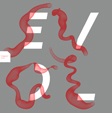 I come to the Diagonal label in search of electronic madness, but this 12″ by Evol pushes beyond my craziest expectations to Wolfgang Voigt levels of repetitive, torturous loops. And I thank them for it! “Flapper That” is broken into two long parts on here, starting off with the sound of an Atari game stuck on a trampoline. Eventually the bounce sound changes, but only slightly, and at such a fast pace that the ten-or-so minutes per side feels at least twice as long. That’s all there is, beyond a constant hum of bass on the second part: a single rubbery synth loop modulated in pitch and frequency. I’m picturing some person in an all-white room in a long white lab-coat, playing a synth that was built with Twizzlers instead of keys and Skittles instead of knobs, turning it on letting it play itself as they furiously take notes on a clipboard. Maddening music to the utmost degree, and essentially exactly where I want Diagonal to take me in late 2015.
I come to the Diagonal label in search of electronic madness, but this 12″ by Evol pushes beyond my craziest expectations to Wolfgang Voigt levels of repetitive, torturous loops. And I thank them for it! “Flapper That” is broken into two long parts on here, starting off with the sound of an Atari game stuck on a trampoline. Eventually the bounce sound changes, but only slightly, and at such a fast pace that the ten-or-so minutes per side feels at least twice as long. That’s all there is, beyond a constant hum of bass on the second part: a single rubbery synth loop modulated in pitch and frequency. I’m picturing some person in an all-white room in a long white lab-coat, playing a synth that was built with Twizzlers instead of keys and Skittles instead of knobs, turning it on letting it play itself as they furiously take notes on a clipboard. Maddening music to the utmost degree, and essentially exactly where I want Diagonal to take me in late 2015.
Frau Mira 7″ (no label)
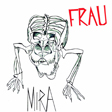 One of my greatest regrets of this summer is missing Frau as they came through my town on tour. It was an unavoidable conflict, but I now have no choice but to wonder how these maniacal, unhinged punk songs sound live, if only because I can hardly believe that music this frantic and unrestrained exists on our planet. “Mira” opens with a hailstorm of noise that would make Derek Bailey and Chris Corsano sit up straight, before blasting into a two-note / no-chord barrage of primitive hardcore-punk. The other three tracks are just as manic, somewhere between Texas obscurities Foams and Rhode Island avant-punk noisers Dynasty, just pure musical beauty. The 7″ comes with a lyric sheet, and while Frau sing exclusively in English, following along with the lyrics while listening is an intense and near-impossible task, like performing two heart surgeries as once. God I love Frau.
One of my greatest regrets of this summer is missing Frau as they came through my town on tour. It was an unavoidable conflict, but I now have no choice but to wonder how these maniacal, unhinged punk songs sound live, if only because I can hardly believe that music this frantic and unrestrained exists on our planet. “Mira” opens with a hailstorm of noise that would make Derek Bailey and Chris Corsano sit up straight, before blasting into a two-note / no-chord barrage of primitive hardcore-punk. The other three tracks are just as manic, somewhere between Texas obscurities Foams and Rhode Island avant-punk noisers Dynasty, just pure musical beauty. The 7″ comes with a lyric sheet, and while Frau sing exclusively in English, following along with the lyrics while listening is an intense and near-impossible task, like performing two heart surgeries as once. God I love Frau.
Gel Set Human Salad LP (Moniker)
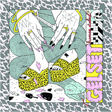 Gel Set entered my consciousness via 2014’s split EP with Stacian, a fellow Midwestern dabbler of vocal-led techno/synth-pop, and now she’s keeping the party going with this attractive new LP. The cover art is worthy of its own Fantagraphics title (nice work, Otto Splotch!), and the music is much as I had expected: think the earliest 100% Silk releases (Innergaze, Maria Minerva, Body Double, let’s say) with the bite of Tamion 12 Inch and the Ersatz Audio crew, and a residual hint of the electro-perversion of Crack: We Are Rock and Tracy & The Plastics. That enough band names for you? There’s usually a drum machine popping like popcorn while a scary bass-line darts beneath, all as Laura Callier (the sole proprietor of Gel Set) talks, coos and mumbles her way through an unlit basement hallway. As far as left-field synth-pop, it’s actually a pretty unobtrusive album, as I’ve put it on a few times only to forget I was listening to it – sometimes Gel Set’s lightweight grooves blend into my desk fan ambiance a little too easily. Still, when she has my full attention, I can’t help but wish I had a portable smoke machine and mirrored dance-floor to moonwalk myself onto, which is really what it all comes down to.
Gel Set entered my consciousness via 2014’s split EP with Stacian, a fellow Midwestern dabbler of vocal-led techno/synth-pop, and now she’s keeping the party going with this attractive new LP. The cover art is worthy of its own Fantagraphics title (nice work, Otto Splotch!), and the music is much as I had expected: think the earliest 100% Silk releases (Innergaze, Maria Minerva, Body Double, let’s say) with the bite of Tamion 12 Inch and the Ersatz Audio crew, and a residual hint of the electro-perversion of Crack: We Are Rock and Tracy & The Plastics. That enough band names for you? There’s usually a drum machine popping like popcorn while a scary bass-line darts beneath, all as Laura Callier (the sole proprietor of Gel Set) talks, coos and mumbles her way through an unlit basement hallway. As far as left-field synth-pop, it’s actually a pretty unobtrusive album, as I’ve put it on a few times only to forget I was listening to it – sometimes Gel Set’s lightweight grooves blend into my desk fan ambiance a little too easily. Still, when she has my full attention, I can’t help but wish I had a portable smoke machine and mirrored dance-floor to moonwalk myself onto, which is really what it all comes down to.
Golden Bats Godhead / Bunny Lake 7″ (Coffin Cut)
 Golden Bats is the solo project of Geordie Stafford of Australian hardcore group Teargas, and he uses the opportunity to slow things down considerably, genuflecting honorably in front of the Electric Guitar. “Godhead” coasts on an epic tuned-down riff comparable to Melvins or Neurosis, working its Sabbath-approved chords into new arrangements and eventually belting out some gruff, misty vocals through the din. “Bunny Lake” operates similarly, like Goatsnake covering Bongzilla with a little Iron Monkey in the tank (and a Kerry King-esque guitar solo toward the end). There are millions of bands that sound just like this, but there are millions of different chocolate cakes out there that all taste like chocolate cake, and you wouldn’t catch me complaining about that, you know? There can never be enough down-tuned doom-metal as far as I’m concerned, so if you happen to encounter Golden Bats, it won’t take much effort to enjoy yourself.
Golden Bats is the solo project of Geordie Stafford of Australian hardcore group Teargas, and he uses the opportunity to slow things down considerably, genuflecting honorably in front of the Electric Guitar. “Godhead” coasts on an epic tuned-down riff comparable to Melvins or Neurosis, working its Sabbath-approved chords into new arrangements and eventually belting out some gruff, misty vocals through the din. “Bunny Lake” operates similarly, like Goatsnake covering Bongzilla with a little Iron Monkey in the tank (and a Kerry King-esque guitar solo toward the end). There are millions of bands that sound just like this, but there are millions of different chocolate cakes out there that all taste like chocolate cake, and you wouldn’t catch me complaining about that, you know? There can never be enough down-tuned doom-metal as far as I’m concerned, so if you happen to encounter Golden Bats, it won’t take much effort to enjoy yourself.
Helta Skelta Reds / The Devil’s Triangle 7″ (Rock Bottom)
 You’d think I’d know every Australian punk band by now, but each week there are like another dozen I’ve never heard before, like Perth’s Helta Skelta for instance. This is kind of a strange one: a recent US pressing of their self-released 7″ single from 2013, but I can understand the appeal while listening to “Reds” – it hits the sweet spot between early Total Control and The Vicious, looking back at the earliest Australian punk singles with clear admiration. I’m a little confused by the b-side choice though, as it’s an instrumental that plays out like the mid-section of The Victims’ classic “Disco Junkies”… cool sound for sure, but c’mon, y’all couldn’t come up with any words to sing over it? At the very least, this single has done a fine job of whetting my appetite for more of their classically-trained proto-punk / post-punk rumble, presuming more is on the way eventually.
You’d think I’d know every Australian punk band by now, but each week there are like another dozen I’ve never heard before, like Perth’s Helta Skelta for instance. This is kind of a strange one: a recent US pressing of their self-released 7″ single from 2013, but I can understand the appeal while listening to “Reds” – it hits the sweet spot between early Total Control and The Vicious, looking back at the earliest Australian punk singles with clear admiration. I’m a little confused by the b-side choice though, as it’s an instrumental that plays out like the mid-section of The Victims’ classic “Disco Junkies”… cool sound for sure, but c’mon, y’all couldn’t come up with any words to sing over it? At the very least, this single has done a fine job of whetting my appetite for more of their classically-trained proto-punk / post-punk rumble, presuming more is on the way eventually.
Howling Gruel Jolly Jape LP (Wormwood Grasshopper)
 Always nice to see the name “Wormwood Grasshopper” hidden somewhere on a vinyl product, as this Australian label revels in gleeful amateurism like few other. Howling Gruel are new to me (although my intuition tells me the players are not, perhaps doing time in Hammering The Cramps or Drunk Elk or Lord knows who else), and with their shambolic sound, such a link would certainly makes sense. Someone’s usually playing some sort of portable keyboard on Jolly Jape, and they seem to be the leader of the group, as the guitarist seems to be following along via sonic and visual clues (perhaps a head-nod across the studio). The vocalist picks up the melody and does his best to mimic it, and the drummer, who seems to be equipped with half a dozen cardboard boxes of varying structural integrity, will play along until they get bored and decide to imitate Brian Chippendale for the absolute good of no one. In the first few songs, I found myself checking my phone and wishing things would hurry up, but by the time I was halfway through the second side I was truly enamored with this peculiar trio. It’s like when you see a person in a club and their outfit absolutely revolts you when you first see them, and a year later they’re your personal style icon. There’s a giant essay on the back cover that I haven’t read, because I assume it says basically the same thing.
Always nice to see the name “Wormwood Grasshopper” hidden somewhere on a vinyl product, as this Australian label revels in gleeful amateurism like few other. Howling Gruel are new to me (although my intuition tells me the players are not, perhaps doing time in Hammering The Cramps or Drunk Elk or Lord knows who else), and with their shambolic sound, such a link would certainly makes sense. Someone’s usually playing some sort of portable keyboard on Jolly Jape, and they seem to be the leader of the group, as the guitarist seems to be following along via sonic and visual clues (perhaps a head-nod across the studio). The vocalist picks up the melody and does his best to mimic it, and the drummer, who seems to be equipped with half a dozen cardboard boxes of varying structural integrity, will play along until they get bored and decide to imitate Brian Chippendale for the absolute good of no one. In the first few songs, I found myself checking my phone and wishing things would hurry up, but by the time I was halfway through the second side I was truly enamored with this peculiar trio. It’s like when you see a person in a club and their outfit absolutely revolts you when you first see them, and a year later they’re your personal style icon. There’s a giant essay on the back cover that I haven’t read, because I assume it says basically the same thing.
Ital Toxic Work Environment 12″ (Gang Of Ducks)
 Daniel Martin-McCormick (aka Ital) has always had a knack for coming up with vivid and striking track titles; who doesn’t want to hear a techno track called “Toxic Work Environment” or “Canker Sore”, both of which appear here? He’s been busy putting out all sorts of records, remixes and mixes lately, and I was overdue for checking in, so this new EP seemed like as good a place as any. After spinning a few times, I’m a bit surprised at how Toxic Work Environment sounds, because it’s strikingly normal. There aren’t any crazy vocal effects, unquantized loops, barely restrained emotional glee or any of Ital’s signifiers, just a very sturdy and workmanlike set of dark techno songs, ready to be played over a powerful club system after midnight by Adam X or Planetary Assault Systems. It’s cool stuff for sure, I just kept waiting for clear evidence that D.M.M. was behind these tracks to materialize and it never did. As it turns out, my favorite cut is probably the G.O.D. “rework” of “The Citadel”, which breaks the drums down into a jittery pile of plywood and nails as rusty bass saws through it. I’ll admit, hearing Ital violently cut up Lady Gaga vocals wasn’t exactly the sort of thing I wanted to hear all the time, but this surprisingly unsurprising EP has me missing his shoeless exuberance at least a little bit.
Daniel Martin-McCormick (aka Ital) has always had a knack for coming up with vivid and striking track titles; who doesn’t want to hear a techno track called “Toxic Work Environment” or “Canker Sore”, both of which appear here? He’s been busy putting out all sorts of records, remixes and mixes lately, and I was overdue for checking in, so this new EP seemed like as good a place as any. After spinning a few times, I’m a bit surprised at how Toxic Work Environment sounds, because it’s strikingly normal. There aren’t any crazy vocal effects, unquantized loops, barely restrained emotional glee or any of Ital’s signifiers, just a very sturdy and workmanlike set of dark techno songs, ready to be played over a powerful club system after midnight by Adam X or Planetary Assault Systems. It’s cool stuff for sure, I just kept waiting for clear evidence that D.M.M. was behind these tracks to materialize and it never did. As it turns out, my favorite cut is probably the G.O.D. “rework” of “The Citadel”, which breaks the drums down into a jittery pile of plywood and nails as rusty bass saws through it. I’ll admit, hearing Ital violently cut up Lady Gaga vocals wasn’t exactly the sort of thing I wanted to hear all the time, but this surprisingly unsurprising EP has me missing his shoeless exuberance at least a little bit.
Ivy A Cat’s Cause No Dog’s Problem 7″ (Katorga Works)
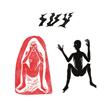 I noticed that Katorga Works pressed a thousand copies of this new (and ostensibly final) Ivy 7″, and that sort of information gives me hope that quality underground hardcore bands can still sell four figures’ worth of seven-inch EPs, even as the format grows more obsolete and cost-prohibitive. If the quality of the music is any factor into those statistics, it makes sense, as this is another excellent set of uniquely ramshackle hardcore-punk tunes. These songs flop like wet fish, like each player is trying to forcibly adjust the song’s tempo or direction at the same time: maybe the guitarist will suddenly play extra-fast, or the drummer will throw in a couple extra rolls that seem to indicate “I’m bored, let’s mix it up”. I’m reminded of old punks as varied as Adrenalin OD and the ERL Records label, as well as modern friends-of-the-band like the Total State community or Mystic Inane. It’s all very Ivy though, and while the news that they have broken up sucks, I will enjoy these records for years to come.
I noticed that Katorga Works pressed a thousand copies of this new (and ostensibly final) Ivy 7″, and that sort of information gives me hope that quality underground hardcore bands can still sell four figures’ worth of seven-inch EPs, even as the format grows more obsolete and cost-prohibitive. If the quality of the music is any factor into those statistics, it makes sense, as this is another excellent set of uniquely ramshackle hardcore-punk tunes. These songs flop like wet fish, like each player is trying to forcibly adjust the song’s tempo or direction at the same time: maybe the guitarist will suddenly play extra-fast, or the drummer will throw in a couple extra rolls that seem to indicate “I’m bored, let’s mix it up”. I’m reminded of old punks as varied as Adrenalin OD and the ERL Records label, as well as modern friends-of-the-band like the Total State community or Mystic Inane. It’s all very Ivy though, and while the news that they have broken up sucks, I will enjoy these records for years to come.
Kerridge Sonic Instruments Of War 7″ (Contort)
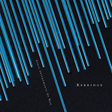 A new 7″ single from the mighty Kerridge, entitled Sonic Instruments Of War? I can’t help but cut to the front of the line for this one! As it turns out, this EP offers two live tracks from one of his recent Contort sets (the loosely dance-based event Kerridge and his wife Hayley curate), and I dunno, it doesn’t come close to matching the sonic magnitude of his fantastic second album that still accompanies my many daily activities. “Sonic Instruments Of War #01” has him pressing the pause button repeatedly on a basic-yet-raw drum n’ bass break while a red-lining wave of static cuts through the atmosphere like a torpedo. “Sonic Instruments Of War #02″ is much more my speed, borrowing a cosmic flatulent ripple from Emptyset (where have those guys been lately anyway?) and pairing it with a chopped and distorted drill-sergeant vocal, not unlike Genocide Organ or Grey Wolves on a particularly bass-heavy tirade. It’s cool, but nothing that bears repeat listens for a guy like me – neither aspect of the track is particularly impressive, and their sum is equal to its parts. While the second track is killer, it’s tough to justify purchasing this 7”, though, unless you’re a fellow Kerridge-aholic. And even then, you might want to download some MP3s and continue to squirrel away your finances for his next studio release, whenever that may be.
A new 7″ single from the mighty Kerridge, entitled Sonic Instruments Of War? I can’t help but cut to the front of the line for this one! As it turns out, this EP offers two live tracks from one of his recent Contort sets (the loosely dance-based event Kerridge and his wife Hayley curate), and I dunno, it doesn’t come close to matching the sonic magnitude of his fantastic second album that still accompanies my many daily activities. “Sonic Instruments Of War #01” has him pressing the pause button repeatedly on a basic-yet-raw drum n’ bass break while a red-lining wave of static cuts through the atmosphere like a torpedo. “Sonic Instruments Of War #02″ is much more my speed, borrowing a cosmic flatulent ripple from Emptyset (where have those guys been lately anyway?) and pairing it with a chopped and distorted drill-sergeant vocal, not unlike Genocide Organ or Grey Wolves on a particularly bass-heavy tirade. It’s cool, but nothing that bears repeat listens for a guy like me – neither aspect of the track is particularly impressive, and their sum is equal to its parts. While the second track is killer, it’s tough to justify purchasing this 7”, though, unless you’re a fellow Kerridge-aholic. And even then, you might want to download some MP3s and continue to squirrel away your finances for his next studio release, whenever that may be.
L.O.T.I.O.N. Digital Control And Man’s Obsolescence LP (Toxic State)
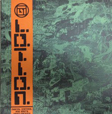 From what I’d heard, it was my understanding that L.O.T.I.O.N. were the New York hardcore band taking on G.I.S.M.’s Military Affairs Neurotic as their clear and direct inspiration. Sounded cool enough to check out (I admittedly did not pick up the split USB earring that contained their earlier material), but after numerous spins I am still feeling kind of blindsided by how fantastic L.O.T.I.O.N.’s album is, and how it goes far beyond G.I.S.M. pastiche. This is supremely ugly music, that’s for sure… it starts off sounding like Dawn Of Humans covering Ministry, and quickly unravels in various industrial/punk directions, each more raw and brutal than the last. Is that Nitzer Ebb covering Crucifix? Early SPK throttling Sexa? Portion Control using Neubaten’s scrap-metal snare drum while Robocop is dragged behind a horse-drawn cart, Hector-style??? I don’t think I’ve ever heard a modern punk band integrate electronics and ostensibly-techno beats as seamlessly (and ferociously) as on here. I can smell the G.I.S.M. in the visual presentation of this album (as well as the bleach-soaked vocals), but L.O.T.I.O.N. have crafted a world all their own, where computers are attacking humans who are attacking cyborgs and there is no obvious hero or villain, just a pile of consumable violence for us to wade through. Naturally I’m interested in what you think as well, but as far as I’m concerned this is the punk album of the year.
From what I’d heard, it was my understanding that L.O.T.I.O.N. were the New York hardcore band taking on G.I.S.M.’s Military Affairs Neurotic as their clear and direct inspiration. Sounded cool enough to check out (I admittedly did not pick up the split USB earring that contained their earlier material), but after numerous spins I am still feeling kind of blindsided by how fantastic L.O.T.I.O.N.’s album is, and how it goes far beyond G.I.S.M. pastiche. This is supremely ugly music, that’s for sure… it starts off sounding like Dawn Of Humans covering Ministry, and quickly unravels in various industrial/punk directions, each more raw and brutal than the last. Is that Nitzer Ebb covering Crucifix? Early SPK throttling Sexa? Portion Control using Neubaten’s scrap-metal snare drum while Robocop is dragged behind a horse-drawn cart, Hector-style??? I don’t think I’ve ever heard a modern punk band integrate electronics and ostensibly-techno beats as seamlessly (and ferociously) as on here. I can smell the G.I.S.M. in the visual presentation of this album (as well as the bleach-soaked vocals), but L.O.T.I.O.N. have crafted a world all their own, where computers are attacking humans who are attacking cyborgs and there is no obvious hero or villain, just a pile of consumable violence for us to wade through. Naturally I’m interested in what you think as well, but as far as I’m concerned this is the punk album of the year.
Galcher Lustwerk I Neva Seen EP 12″ (Lustwerk Music)
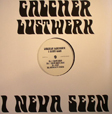 Why bother with a proper label when your grooves sell themselves? That’s what Galcher Lustwerk is asking via his new Lustwerk Music label, this being the second of two 12″ EPs to hit this year. I still haven’t stopped spinning Parlay on a weekly basis and now I’ve got I Neva Seen to keep it company. For Lustwerk fans, naturally you’ll need all these records too, but for the casual fan of nocturnal urban house music, I’d recommend you grab Parlay and determine if you need this one at a later time. “I Neva Seen” features one of Lustwerk’s catchiest hooks (he even does a little singing alongside his barely-awake rap-speak), but the rest of the EP has more of an odds-and-ends vibe: there’s an instrumental version of “I Neva Seen” (nice, but the vocal version is clearly superior), a drifting drone track (“Stem”) and an enjoyable-but-basic track that name-checks Mr. Lustwerk (“Cricket’s Theme”). Almost feels like one of Omar S’s “it’s up to you to do something cool with it” 12″s, but with such a limited number of Lustwerk tracks on vinyl, I could’ve gone for some of his more realized cuts. Then again, when it comes to Galcher Lustwerk, I can’t help but act greedy.
Why bother with a proper label when your grooves sell themselves? That’s what Galcher Lustwerk is asking via his new Lustwerk Music label, this being the second of two 12″ EPs to hit this year. I still haven’t stopped spinning Parlay on a weekly basis and now I’ve got I Neva Seen to keep it company. For Lustwerk fans, naturally you’ll need all these records too, but for the casual fan of nocturnal urban house music, I’d recommend you grab Parlay and determine if you need this one at a later time. “I Neva Seen” features one of Lustwerk’s catchiest hooks (he even does a little singing alongside his barely-awake rap-speak), but the rest of the EP has more of an odds-and-ends vibe: there’s an instrumental version of “I Neva Seen” (nice, but the vocal version is clearly superior), a drifting drone track (“Stem”) and an enjoyable-but-basic track that name-checks Mr. Lustwerk (“Cricket’s Theme”). Almost feels like one of Omar S’s “it’s up to you to do something cool with it” 12″s, but with such a limited number of Lustwerk tracks on vinyl, I could’ve gone for some of his more realized cuts. Then again, when it comes to Galcher Lustwerk, I can’t help but act greedy.
The Mothmen Pay Attention LP (On U-Sound)
 On U-Sound released the debut Mothmen album back in 1981, and now they’ve gone and reissued it again, eager to infiltrate fresh ears. I’ll be honest and admit my ignorance of this British post-punk group’s existence until recently, and with an earlier 7″ release on the great Absurd Records label, I suppose I have no excuse. It’s fun catching up now though, as The Mothmen have a pretty nice sound: disco beats, eclectic songwriting and avant-pop aspirations reverberate here. Think of Contortions if they signed to Recommended Records, or Gang Of Four if they featured ex-members of Henry Cow and went on to form Talk Talk (maybe I should stop writing reviews and get into post-punk fan-fiction instead). The a-side has a nice suite of songs (“Factory / Teapoint / Factory” is my favorite of the bunch) and the b-side stretches out for “Mothman”, a lengthy answer to the question “what would happen if Kid Creole joined This Heat?”, full of spiraling percussion and manic concentration to rival Glenn Branca. As if we needed any further proof that 1981 was one of the greatest years of recorded music.
On U-Sound released the debut Mothmen album back in 1981, and now they’ve gone and reissued it again, eager to infiltrate fresh ears. I’ll be honest and admit my ignorance of this British post-punk group’s existence until recently, and with an earlier 7″ release on the great Absurd Records label, I suppose I have no excuse. It’s fun catching up now though, as The Mothmen have a pretty nice sound: disco beats, eclectic songwriting and avant-pop aspirations reverberate here. Think of Contortions if they signed to Recommended Records, or Gang Of Four if they featured ex-members of Henry Cow and went on to form Talk Talk (maybe I should stop writing reviews and get into post-punk fan-fiction instead). The a-side has a nice suite of songs (“Factory / Teapoint / Factory” is my favorite of the bunch) and the b-side stretches out for “Mothman”, a lengthy answer to the question “what would happen if Kid Creole joined This Heat?”, full of spiraling percussion and manic concentration to rival Glenn Branca. As if we needed any further proof that 1981 was one of the greatest years of recorded music.
Northern Liberties Errant Ray LP (no label)
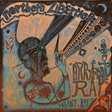 Northern Liberties have slowly become an under-appreciated Philadelphia institution, this being their sixth full length album since the turn of the millennium. They seem to have an endless supply of songs and art pencils with which to draw the artwork that surrounds them, and this new album is as good a selection as any. Like most bands with half a dozen albums under their belt, they really sound a lot like themselves, to the point where Northern Liberties can (consciously or unconsciously) appropriate Fugazi rhythms, pop-punk riffs, Hum’s deft balance of the heavy and melodic, Load Records’ neon scree and a dozen other musical signifiers I’m missing without ever feeling like a direct rip-off or homage to anyone besides Northern Liberties. For a band that is just a bassist, vocalist and drummer, they cover the sonic spectrum pretty well, rather than homing in on a very specific and singular vibe ala Ed Schrader’s Music Beat. The lyrics tend to quickly drift off into prog-fantasy territory, not unlike fellow underground scribblers Human Host (you better believe there’s the line “paramecium – gaze upon the flame”). I can’t imagine anyone would try to stop Northern Liberties from continuing, so maybe they’ll go on forever?
Northern Liberties have slowly become an under-appreciated Philadelphia institution, this being their sixth full length album since the turn of the millennium. They seem to have an endless supply of songs and art pencils with which to draw the artwork that surrounds them, and this new album is as good a selection as any. Like most bands with half a dozen albums under their belt, they really sound a lot like themselves, to the point where Northern Liberties can (consciously or unconsciously) appropriate Fugazi rhythms, pop-punk riffs, Hum’s deft balance of the heavy and melodic, Load Records’ neon scree and a dozen other musical signifiers I’m missing without ever feeling like a direct rip-off or homage to anyone besides Northern Liberties. For a band that is just a bassist, vocalist and drummer, they cover the sonic spectrum pretty well, rather than homing in on a very specific and singular vibe ala Ed Schrader’s Music Beat. The lyrics tend to quickly drift off into prog-fantasy territory, not unlike fellow underground scribblers Human Host (you better believe there’s the line “paramecium – gaze upon the flame”). I can’t imagine anyone would try to stop Northern Liberties from continuing, so maybe they’ll go on forever?
Permanent Makeup Taker LP (No Clear)
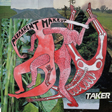 Straight from the majestic plains and valleys of Florida, here comes Permanent Makeup with their second full-length outing, released on their own label. The back cover shows them playing in some dank basement, re-imagined as a solar flight, and it’s that ability to dream beyond their natural surroundings that surely inspires them onward. This record is pretty cool: they go pretty heavy on the basement Sonic Youth vibes, with odd, propulsive melodies and plenty of heavily-effected guitar freakouts. The vocals come through almost painfully direct and without any added reverb or distortion, so it’s almost like the neighbor next-door complaining that the band needs to turn down has unexpectedly taken on vocal duties. Maybe they’re a little Pere Ubu-ish, in that regard? Sounds good to me either way, to the point where the fact that the bassist is wearing shorts in the live band shot hasn’t deterred me from listening. It’s hot down there, sure, but only a select few can truly rock out with bare calves.
Straight from the majestic plains and valleys of Florida, here comes Permanent Makeup with their second full-length outing, released on their own label. The back cover shows them playing in some dank basement, re-imagined as a solar flight, and it’s that ability to dream beyond their natural surroundings that surely inspires them onward. This record is pretty cool: they go pretty heavy on the basement Sonic Youth vibes, with odd, propulsive melodies and plenty of heavily-effected guitar freakouts. The vocals come through almost painfully direct and without any added reverb or distortion, so it’s almost like the neighbor next-door complaining that the band needs to turn down has unexpectedly taken on vocal duties. Maybe they’re a little Pere Ubu-ish, in that regard? Sounds good to me either way, to the point where the fact that the bassist is wearing shorts in the live band shot hasn’t deterred me from listening. It’s hot down there, sure, but only a select few can truly rock out with bare calves.
Pig Eyes 2nd Album LP (Electric Assault)
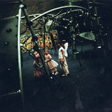 Do you think there is an Acoustic Assault Records out there somewhere? How can I get on their promo list? Anyway, Pig Eyes are a Swedish sextet (although judging from their mugshots on the back cover, two of them look like the same guy with or without large sunglasses on), and while they seem like fun, they take their music seriously. It’s fairly interesting – on the opening track, imagine Queens Of The Stone Age riffs, but used the way Swans play their music. It’s like they take modern radio-rock riffs and bludgeon them repeatedly, or stretch them out far beyond pop structures, like Neu! doing the Franz Ferdinand catalog while wearing Circle’s Judas Priest outfits. 2nd Album would probably fit somewhere in the broadly-defined “noise rock” section of your local Sam Goody, though, at least to those who aren’t listening particularly attentively. Swedes, man – I’m pretty sure their government pays people healthy living wages just to start obscure bands like this, and I’m going to try my best to pretend I’m not insanely jealous.
Do you think there is an Acoustic Assault Records out there somewhere? How can I get on their promo list? Anyway, Pig Eyes are a Swedish sextet (although judging from their mugshots on the back cover, two of them look like the same guy with or without large sunglasses on), and while they seem like fun, they take their music seriously. It’s fairly interesting – on the opening track, imagine Queens Of The Stone Age riffs, but used the way Swans play their music. It’s like they take modern radio-rock riffs and bludgeon them repeatedly, or stretch them out far beyond pop structures, like Neu! doing the Franz Ferdinand catalog while wearing Circle’s Judas Priest outfits. 2nd Album would probably fit somewhere in the broadly-defined “noise rock” section of your local Sam Goody, though, at least to those who aren’t listening particularly attentively. Swedes, man – I’m pretty sure their government pays people healthy living wages just to start obscure bands like this, and I’m going to try my best to pretend I’m not insanely jealous.
Ragtime Frank I’m A Rocketship For My Lord LP (Little Big Chief)
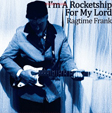 On first glance, I couldn’t help but assume “Ragtime Frank” was one of the Sun City Girls’ more-obscure aliases – the man on the cover even looks like a Bishop brother. Research proves that it isn’t, though, but rather some Australian guy with two prior albums on the sorely-missed Negative Guest List label, both of which landed somewhere off my radar. The back cover reveals that I’m A Rocketship For My Lord was recorded in one take back in July 2013, and I am not one to doubt their claim. Ragtime Frank plays his guitar with apparently thumbs only, approximating some form of the blues that sidesteps melody and tone entirely, using the electrified guitar as some sort of electric buzzer, while the drums of one Leighton Craig keep time. You can almost hear them nodding at each other to signify song stoppage or a change of parts, and occasionally Mr. Frank will let all six strings reverberate at once, nearly drowning out everything else in the room. Picture Maher Shalal Hash Baz on a Howlin’ Wolf kick, or Tetuzi Akiyama with his hands cut off and you’re kinda close to this record’s sensibility. This is the butter with which Little Big Chief swabs their bread, and a fine addition to their family of unspeakably amateurish horror-rock.
On first glance, I couldn’t help but assume “Ragtime Frank” was one of the Sun City Girls’ more-obscure aliases – the man on the cover even looks like a Bishop brother. Research proves that it isn’t, though, but rather some Australian guy with two prior albums on the sorely-missed Negative Guest List label, both of which landed somewhere off my radar. The back cover reveals that I’m A Rocketship For My Lord was recorded in one take back in July 2013, and I am not one to doubt their claim. Ragtime Frank plays his guitar with apparently thumbs only, approximating some form of the blues that sidesteps melody and tone entirely, using the electrified guitar as some sort of electric buzzer, while the drums of one Leighton Craig keep time. You can almost hear them nodding at each other to signify song stoppage or a change of parts, and occasionally Mr. Frank will let all six strings reverberate at once, nearly drowning out everything else in the room. Picture Maher Shalal Hash Baz on a Howlin’ Wolf kick, or Tetuzi Akiyama with his hands cut off and you’re kinda close to this record’s sensibility. This is the butter with which Little Big Chief swabs their bread, and a fine addition to their family of unspeakably amateurish horror-rock.
Sand In The Face Music Made To Riot: New Jersey Hardcore 1982-1983 LP (Made At The World)
 Sand In The Face is one of those band names you can’t help but pause at while scanning the track-listing of The Master Tape, Vol. 2, and while I always assumed they never did anything beyond that, this retrospective LP proves me to be wonderfully wrong. They recorded eighteen tracks in 1982, and I’ll be damned if they aren’t great, very much a clear product of their time but in a positive way. I’m reminded of Ill Repute, the early Mutha singles, maybe some Code Of Honor, and certainly Dischord’s first year in business – the songs are fast and simple, occasionally catchy, highly teenaged and the vocals have that slight touch of roomy reverb that makes me wonder if Cyanamid didn’t record in the same New Jersey studio a few years later. The liner notes offer a detailed and interesting band history (although it saddened me to see that “Sand In The Face is on Facebook”), and now you hopefully won’t have to think exclusively about Floorpunch, Mouthpiece and Ensign when New Jersey hardcore becomes a topic of conversation.
Sand In The Face is one of those band names you can’t help but pause at while scanning the track-listing of The Master Tape, Vol. 2, and while I always assumed they never did anything beyond that, this retrospective LP proves me to be wonderfully wrong. They recorded eighteen tracks in 1982, and I’ll be damned if they aren’t great, very much a clear product of their time but in a positive way. I’m reminded of Ill Repute, the early Mutha singles, maybe some Code Of Honor, and certainly Dischord’s first year in business – the songs are fast and simple, occasionally catchy, highly teenaged and the vocals have that slight touch of roomy reverb that makes me wonder if Cyanamid didn’t record in the same New Jersey studio a few years later. The liner notes offer a detailed and interesting band history (although it saddened me to see that “Sand In The Face is on Facebook”), and now you hopefully won’t have to think exclusively about Floorpunch, Mouthpiece and Ensign when New Jersey hardcore becomes a topic of conversation.
Toupée Leg Toucher LP (Moniker)
 Toupée opt for some bold lettering on the cover of their debut album, not unlike Total Control’s so-ugly-you-can’t-stop-looking Henge Beat, and it suits their maniacal version of post-no-wave whatever music that they’re spilling all over the floor. I like it a lot, in part because they manage to do a lot of different things while sounding like the same band – there’s a Harry Pussy-level freakout in “Come Back To Camp” and it’s followed by a Garbage Pail Kids version of a Runaways song in “School”, and that’s just the start of the b-side! Elsewhere, I’m reminded of the fall-apart skronk of Total Shutdown, the deconstructed anti-blues of fellow Chicagoans US Maple, and the last Erase Errata album before they reformed (Leg Toucher sometimes feels like ugly no-wave growing into tuneful post-grunge guitar-rock ala The Gits or Seaweed). I bet Toupée used to go see The Coughs when they’d play around town, and perhaps they took that sort of unpretentious Tazmanian Devil approach and applied it to a larger set of musical skills. I am dying to know what Toupée look like, as their music doesn’t clearly signify any sort of visual stereotype – guess I’ll have to wait until they come to my town to find out if they have dreads or beards or mohawks or what.
Toupée opt for some bold lettering on the cover of their debut album, not unlike Total Control’s so-ugly-you-can’t-stop-looking Henge Beat, and it suits their maniacal version of post-no-wave whatever music that they’re spilling all over the floor. I like it a lot, in part because they manage to do a lot of different things while sounding like the same band – there’s a Harry Pussy-level freakout in “Come Back To Camp” and it’s followed by a Garbage Pail Kids version of a Runaways song in “School”, and that’s just the start of the b-side! Elsewhere, I’m reminded of the fall-apart skronk of Total Shutdown, the deconstructed anti-blues of fellow Chicagoans US Maple, and the last Erase Errata album before they reformed (Leg Toucher sometimes feels like ugly no-wave growing into tuneful post-grunge guitar-rock ala The Gits or Seaweed). I bet Toupée used to go see The Coughs when they’d play around town, and perhaps they took that sort of unpretentious Tazmanian Devil approach and applied it to a larger set of musical skills. I am dying to know what Toupée look like, as their music doesn’t clearly signify any sort of visual stereotype – guess I’ll have to wait until they come to my town to find out if they have dreads or beards or mohawks or what.
Violence Creeps I’m Broke / Gridlock 7″ flexi (Degenerate)
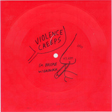 Stapled to the inside of the strangely cool Degenerate fanzine, issue #16, was a red one-sided Violence Creeps flexi. If you’re having trouble moving copies of your fanzine, might I suggest that you include the same? Anyway, this delightful treat went right on my turntable and I was immediately greeted with “I’m Broke”, a gnarly Flipper-ish ballad played on 45 (am I picking up a slight Black Fork vibe as well?), the sort of song that oozes such pure human frustration that even the Koch brothers would approve of its passion on some level. “Gridlock” is another one of modern life’s failures brought into the spotlight by the Violence Creeps, similar in rhythm but with a little more fire in its belly, perhaps because being stuck in gridlock is even worse than being broke. Violence Creeps are truth-tellers, and it would do us all well to listen and listen intently.
Stapled to the inside of the strangely cool Degenerate fanzine, issue #16, was a red one-sided Violence Creeps flexi. If you’re having trouble moving copies of your fanzine, might I suggest that you include the same? Anyway, this delightful treat went right on my turntable and I was immediately greeted with “I’m Broke”, a gnarly Flipper-ish ballad played on 45 (am I picking up a slight Black Fork vibe as well?), the sort of song that oozes such pure human frustration that even the Koch brothers would approve of its passion on some level. “Gridlock” is another one of modern life’s failures brought into the spotlight by the Violence Creeps, similar in rhythm but with a little more fire in its belly, perhaps because being stuck in gridlock is even worse than being broke. Violence Creeps are truth-tellers, and it would do us all well to listen and listen intently.
Beau Wanzer Untitled 12″ (no label)
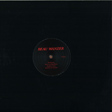 Ah, a fresh delivery of Beau Wanzer tracks, this one coming on presumably the same unnamed label as his album, complete with the same illustration of Freddy Krueger on a first date on the center sticker (maybe this is the official Beau Wanzer logo?). Four tracks here, and they are cool, exploring some different and exciting corners of the electronic underground. It opens with “Beefhearts”, four minutes of wobbly rave beats, intermittent bass throb and a delightfully homemade “haunted house rave” vibe. That shifts to a queasy synth equation titled “Drew Is A Dogeater” that sounds like something off the M Squared boxset, with the sense that the music keeps trying to hit an acid-house groove only to be rejected at the net by Wanzer’s stiff fingers. Flip it for “Seedless Grins”, which seems to sample the overloaded ambiance of air travel and lay it under a pill-popping trance loop; very nice! The final track title “Beaches Of Leeches” sounds like it should be a Kevin Drumm / Wolf Eyes collaboration and I guess it kinda could be, looping what seems to be someone calling for help from inside a locked metal safe into a groove that L.I.E.S. probably wish they owned the publishing on. Beautiful EP all around, and if you haven’t checked out Beau Wanzer yet, I have to wonder why not?
Ah, a fresh delivery of Beau Wanzer tracks, this one coming on presumably the same unnamed label as his album, complete with the same illustration of Freddy Krueger on a first date on the center sticker (maybe this is the official Beau Wanzer logo?). Four tracks here, and they are cool, exploring some different and exciting corners of the electronic underground. It opens with “Beefhearts”, four minutes of wobbly rave beats, intermittent bass throb and a delightfully homemade “haunted house rave” vibe. That shifts to a queasy synth equation titled “Drew Is A Dogeater” that sounds like something off the M Squared boxset, with the sense that the music keeps trying to hit an acid-house groove only to be rejected at the net by Wanzer’s stiff fingers. Flip it for “Seedless Grins”, which seems to sample the overloaded ambiance of air travel and lay it under a pill-popping trance loop; very nice! The final track title “Beaches Of Leeches” sounds like it should be a Kevin Drumm / Wolf Eyes collaboration and I guess it kinda could be, looping what seems to be someone calling for help from inside a locked metal safe into a groove that L.I.E.S. probably wish they owned the publishing on. Beautiful EP all around, and if you haven’t checked out Beau Wanzer yet, I have to wonder why not?
Peter J. Woods Impure Gold Pt. II LP (FTAM)
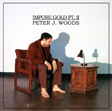 I reviewed Impure Gold Pt. I in these very pages last year, and it’s nice to see that noise artist Peter J. Woods is continuing forward, in the face of what must surely be a whole lot of indifference. His is not an easy music to enjoy, that’s for sure. The a-side “Skin And Movement” is full of dead air, white noise not unlike a window fan and spoken word that comes through so softly, I can’t help but assume Woods is setting me up to put my ear close to the speaker, only to blare an air-horn at me just when I thought I was safe. Occasionally the static flips on and off like you’re going through the channels on a TV with no reception, but ultimately this track falls in the Billy Bao / Francisco López realm of sustained un-pleasurable listening. The b-side continues with the sustained static for a minute or two before a subtle heartbeat and singular piano note usher in a slight variation on the monotonous blankness that colors Woods’ work. That continues with varying levels of grey static until the closing track takes over, which sounds like Woods attempting to open a particularly well-sealed bag of chips while a heart monitor confirms his pulse. I’m not sure that this record would appeal to any of the Yellow Green Red audience, but if it appeals to you, please get in touch, as you’re probably the type of weirdo I’m looking to correspond with.
I reviewed Impure Gold Pt. I in these very pages last year, and it’s nice to see that noise artist Peter J. Woods is continuing forward, in the face of what must surely be a whole lot of indifference. His is not an easy music to enjoy, that’s for sure. The a-side “Skin And Movement” is full of dead air, white noise not unlike a window fan and spoken word that comes through so softly, I can’t help but assume Woods is setting me up to put my ear close to the speaker, only to blare an air-horn at me just when I thought I was safe. Occasionally the static flips on and off like you’re going through the channels on a TV with no reception, but ultimately this track falls in the Billy Bao / Francisco López realm of sustained un-pleasurable listening. The b-side continues with the sustained static for a minute or two before a subtle heartbeat and singular piano note usher in a slight variation on the monotonous blankness that colors Woods’ work. That continues with varying levels of grey static until the closing track takes over, which sounds like Woods attempting to open a particularly well-sealed bag of chips while a heart monitor confirms his pulse. I’m not sure that this record would appeal to any of the Yellow Green Red audience, but if it appeals to you, please get in touch, as you’re probably the type of weirdo I’m looking to correspond with.

